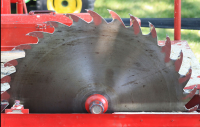








A circular saw is a power-saw using a toothed or abrasive disc or blade to cut different materials using a rotary motion spinning around an arbor. A hole saw and ring saw also uses a rotary motion but are different from a circular saw. Circular saw may also loosely used for the blade itself. Circular saws were invented in the late 18th century and were in common use in sawmills in the United States by the middle of the 19th century.
A circular saw is a tool for cutting many materials such as wood, masonry, plastic, or metal and may be hand-held or mounted to a machine. In woodworking the term ""circular saw"" refers specifically to the hand-held type and the table saw and chop saw are other common forms of circular saws. ""Skilsaw"" has become a generic trademark for conventional hand-held circular saws. Circular saw blades are specially designed for each particular material they are intended to cut and in cutting wood are specifically designed for making rip-cuts, cross-cuts, or a combination of both. Circular saws are commonly powered by electricity, but may be powered by a gasoline engine or a hydraulic motor which allows it to be fastened to heavy equipment, eliminating the need for a separate energy source.
The circular saw was invented around the end of the 18th century as a rip-saw to convert logs into lumber (timber) in sawmills and various claims have been made as to who invented the circular saw. Before the design was invented logs were sawn by hand using a pit saw or using powered saws in a sawmill using an up-and-down saw with a reciprocating motion. The rotary nature of the circular saw requires more power to operate but cuts faster because the teeth are in constant motion. The sound of the circular saw is different from the sound of an up-and-down saw and earned it the nickname buzz-saw.
Sawmills first used smaller diameter circular saws to resaw dimension lumber such as lath and wall studs and for edging boards. As the technology advanced large diameter saw blades began to be used for the head saws and to cut clapboards.
Claims to the invention of the circular saw include:
A common claim is for a little-known sailmaker named Samuel Miller of Southampton, England who obtained a patent in 1777 for a saw windmill.However the specification for this only mentions the form of the saw incidentally, probably indicating that it was not his invention.
Gervinus of Germany is often credited with inventing the circular saw in 1780.
Walter Taylor of Southampton had the blockmaking contract for Portsmouth Dockyard. In about 1762 he built a saw mill where he roughed out the blocks. This was replaced by another mill in 1781. Descriptions of his machinery there in the 1790s show that he had circular saws. Taylor patented two other improvements to blockmaking but not the circular saw.This suggests either that he did not invent it or that he published his invention without patenting it (which would mean it was no longer patentable).
Another claim is that it originated in Holland in the sixteenth or seventeenth century.This may be correct, but nothing more precise is known.
The use of a large circular saw in a saw mill is said to have been invented in 1813 by Tabitha Babbitt, a Shaker inventor, after she noted the inefficiency of the traditional saw pits used by the sawyers in her community and sought an improvement.
The Barringer, Manners and Wallis factory in Rock Valley Mansfield, Nottinghamshire also claims to be the site of the invention.